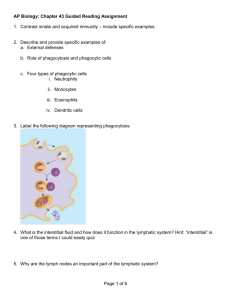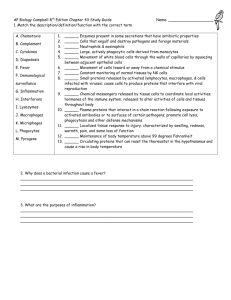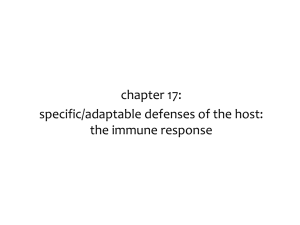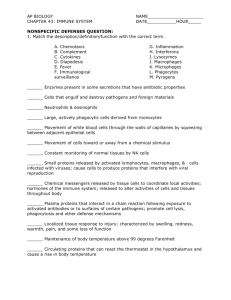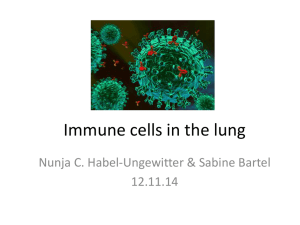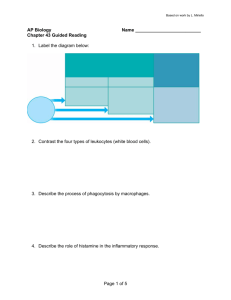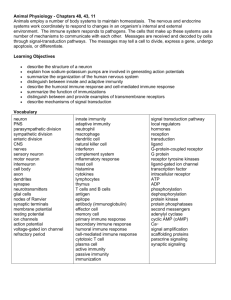Understand-Immunity
advertisement
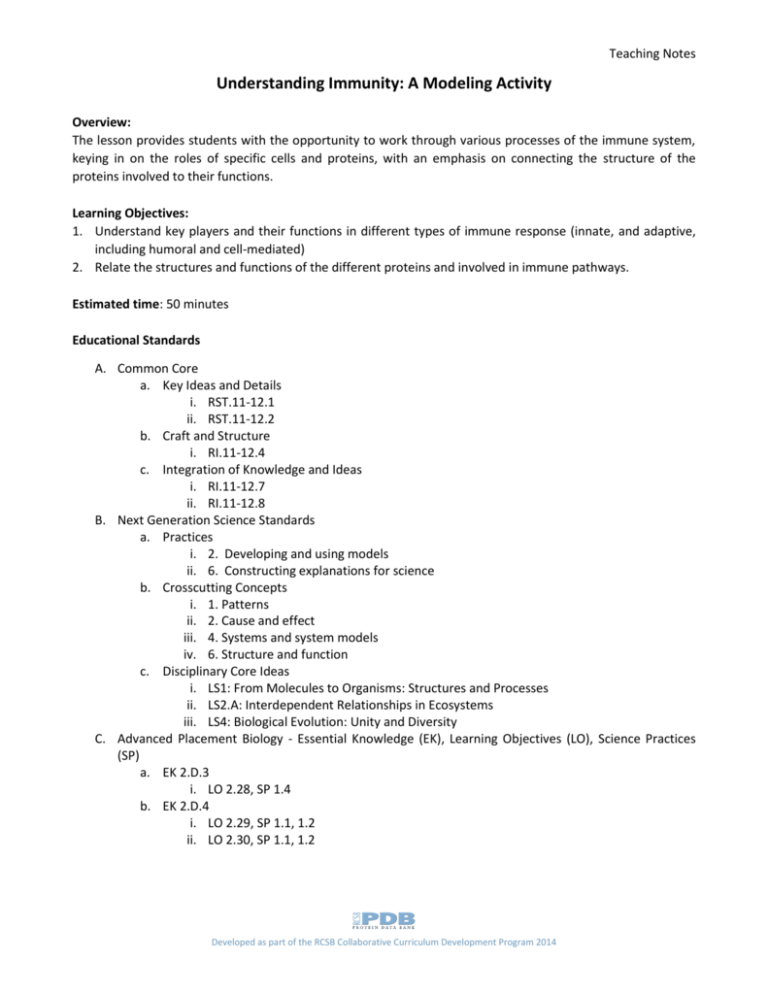
Teaching Notes Understanding Immunity: A Modeling Activity Overview: The lesson provides students with the opportunity to work through various processes of the immune system, keying in on the roles of specific cells and proteins, with an emphasis on connecting the structure of the proteins involved to their functions. Learning Objectives: 1. Understand key players and their functions in different types of immune response (innate, and adaptive, including humoral and cell-mediated) 2. Relate the structures and functions of the different proteins and involved in immune pathways. Estimated time: 50 minutes Educational Standards A. Common Core a. Key Ideas and Details i. RST.11-12.1 ii. RST.11-12.2 b. Craft and Structure i. RI.11-12.4 c. Integration of Knowledge and Ideas i. RI.11-12.7 ii. RI.11-12.8 B. Next Generation Science Standards a. Practices i. 2. Developing and using models ii. 6. Constructing explanations for science b. Crosscutting Concepts i. 1. Patterns ii. 2. Cause and effect iii. 4. Systems and system models iv. 6. Structure and function c. Disciplinary Core Ideas i. LS1: From Molecules to Organisms: Structures and Processes ii. LS2.A: Interdependent Relationships in Ecosystems iii. LS4: Biological Evolution: Unity and Diversity C. Advanced Placement Biology - Essential Knowledge (EK), Learning Objectives (LO), Science Practices (SP) a. EK 2.D.3 i. LO 2.28, SP 1.4 b. EK 2.D.4 i. LO 2.29, SP 1.1, 1.2 ii. LO 2.30, SP 1.1, 1.2 Developed as part of the RCSB Collaborative Curriculum Development Program 2014 Teaching Notes Suggestions for how to use this activity: Materials: Any and all materials on hand can be used to model the proteins and cells in this activity. For example construction paper, pipe cleaners, beads, clay, fabric etc. The main objective in this modeling exercise is that the students should be able to show structure of the cell(s) and/or protein(s) and move the various components around to model their interactions and functions. Safety: No special considerations Planning ahead: Each student should receive a copy of the activity and appropriate modeling materials should be provided. Students may be grouped into groups of 2 or 3 and assigned one of the three themes a. innate response b. cell-mediated response c. humoral response After building the models, the student groups need to work together in larger groups to simulate how all three types of responses (innate, cell-mediated and humoral) interact with each other. Extensions and Modifications After following through the immune response for a single infection, students could try to predict what happens with a second infection of the same pathogen occurs and compare the response with a time line. Also, they could use the same model and use HIV as the pathogen to demonstrate how the virus is difficult to fight. Modeling Activity To understand the function of the immune system, it is helpful to understand the various cells, proteins and complexes involved and relate them to their function. Key ideas: 1. The immune response is a complex set of reactions that relies on interplay among the different cells. 2. Cells communicate with one another using different chemical messengers. Each of these chemical messengers has a structure that is directly related to its function. 3. Immunity is the state of having body defenses, which protect, eliminate and provide future protection against invaders. 4. In vertebrates, immunity can be either innate or adaptive. Innate immunity is general and adaptive is specific to a particular pathogen or infectious agent. Adaptive immunity is effected by two groups of lymphocytes and can be subdivided into the humoral response and the cell-mediated response, each governed by a different group of lymphocytes. Activity: 1. Students will investigate the workings of innate immunity, humoral response and cell-mediated response. 2. Students will work in groups and each group will become the expert for one of the following types of immune responses: a. Innate response b. Humoral response c. Cell-mediated response Developed as part of the RCSB Collaborative Curriculum Development Program 2014 Teaching Notes 3. Students will make a model showing how the assigned type of immune response works and then use it to explain this to other groups. When designing the model, students should demonstrate: a. their understanding of structures as well as the functions of the proteins involved. b. Key cells, structures and proteins for each of the immune responses are listed below c. Models should also show the spatial reference, in other words, students should show where these events are occurring. 4. Students may include additional relevant terms that are not listed here. Key terms that must be included in your model: Innate response Basophils Neutrophils Granulocytes Dendretic-cells Monocytes Mast-cells Macrophages Eosinophils Toll-like-Receptors Histamine Natural-Killer-Cells Complement Lysozyme Cytokines Humoral response Antibodies Constant region Plasma cells Clonal selection Complement system Neutralization of microbe B cell antigen receptor Heavy chain Memory B cells Antigen recognition Epitope Variable region Antigen Disulfide links Antibody surface Light chain Cell-mediated response Antigen-presenting cells Cytotoxic T cells T cell antigen receptor Chemokines Constant region Perforin CD8 cells MHC-I Memory T cells CD4 cells Helper T cells MHC-II Dendritic cells Granzymes Clonal selection 5. After the model is assembled, students should practice the presentation, first in small groups and then in larger groups. The larger groups should consist of members from an innate response group, a humoral response group and a cell-mediated response group. Each group should present the model and explain the processes involved. 6. When all presentations are completed, student can process and summarize the immune response with the activity on the following page. Developed as part of the RCSB Collaborative Curriculum Development Program 2014 Teaching Notes Name_______KEY__________________________Date______________Class_____________ The Immune Response: Assessment for Learning After viewing the models of all the immune responses, complete the following: 1. General Comparison of the three responses: Innate Response How it is initiated: what starts the process? Speed of response Types of cells involved Types of protein molecules involved Is memory acquired? If so, what cells? Humoral Response Cell-Mediated Response Always on—barriers are present and the cells are circulating. Neutrophils are attracted by signals from infected cells. Histamines are released at the site of damage. Antigen is presented to lymphocytes in lymph nodes. When an antigen binds to a B cell, the cell is activated and divides and differentiates into plasma cells. Antigen-presenting cell binds to the antigen receptor for the T cell which divide and differentiate into T helper cells and cytotoxic T cells Immediate, within minutes or hours Slow, may take up to a week Slow, may take up to a week Dendritic, Mast Macrophages Monocytes. Neutrophils, Eosinophils, Basophils, Granulocytes, Natural Killer Cells Toll-like receptors Histamines Cytokines (interferons) Complement proteins B cells: Activated B cells Plasma cells Memory B cells Helper T cells Antigen-presenting cells Helper T cells Cytotoxic T cells Memory T cells Antigen Epitope Antibodies B cell antigen receptor T cell receptors MHC I, MHC II CD4, CD8, Chemokines, Perforin No memory Memory B cells Memory T cells 2. Compare and contrast MHC I and MHC II. What is the significance of each? Which cells have MHC II? How does the presence of MHC relate to the functions of these cells? MHC I and MHC II are the two classes of the major histocompatibility complex. Both MHC I and MHC II are cell surface proteins. They function by displaying the epitope of the processed antigen. When certain cells, such as macrophages and dendritic cells are infected, they process the antigen and display the antigenic epitopes (e.g. short peptides) on the MHC complex. T cells recognize the presented antigens by binding to the MHC complexes via T-Cell Receptors and are activated by this presentation. MHC I proteins are found on nearly all nucleated cells; when displaying the epitope of the antigen, these will activate cytotoxic T cells. MHC II proteins are found on dendritic cells, macrophages and B cells; when displaying the epitope of the antigen will activate helper T cells. Developed as part of the RCSB Collaborative Curriculum Development Program 2014 Teaching Notes 3. What in the complement system? Is it involved in both innate and adaptive immunities? Explain. The complement system is a group of proteins found in blood plasma. They function in both innate and adaptive immunities. In innate immunity, the activated complement proteins can stimulate the release of more histamine, which attracts phagocytes. In adaptive immunity, complement proteins bind to the antigenantibody complex on the pathogenic cell and promote the formation of a pore in the pathogen which allows water and ions to rush in and lyse the pathogen. 4. You have an ear infection and the culprit is the adenovirus. Using a flow chart or infographic, show how the immune system responds to the virus. Answers may vary. Students should show both innate and adaptive immunities and include the major events of each immune response. Developed as part of the RCSB Collaborative Curriculum Development Program 2014
